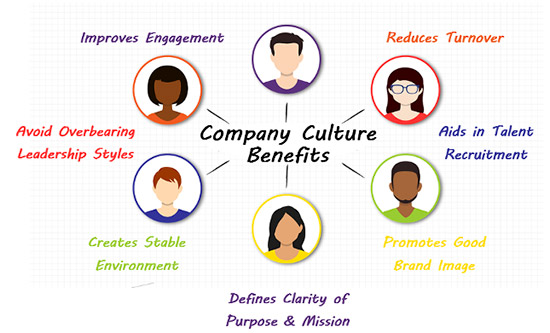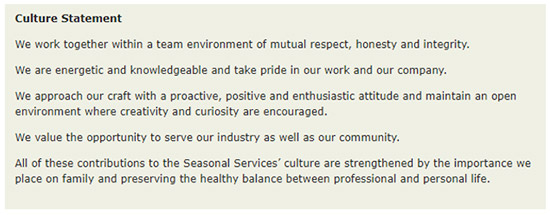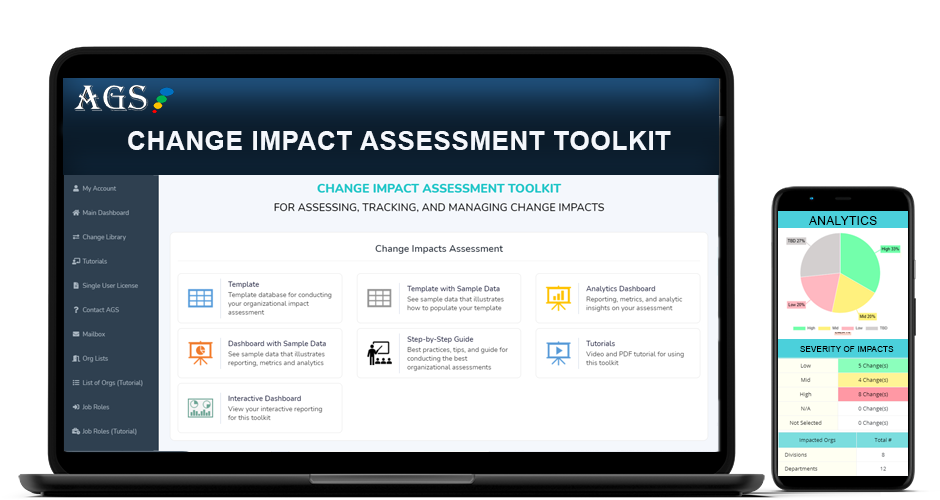Company Culture Examples, Definition, & How to Build Good Company Culture | Everything you Need
When you think of people you know, you might describe them as being funny, helpful, sensitive, or talented. These types of descriptors make up that person’s perceived personality.
Words to describe company culture are a little different – competitive, innovative, nurturing, bureaucratic – but they end up also being the way others perceive an organization’s personality.
There are many different types of a company culture that an organization may have. Organizations can be known as controlling and run by rules and regulations. Others might be seen as clan-like with a very tight-knit team that all moves in the same direction.
Company culture types can be defined by an organization itself (that’s generally how you want to do it) or they can be defined by various leaders inside a company.
In the case of company culture defined by individuals instead of the organization as a whole, one department might have one company culture meaning, and another department may operate under a completely different company culture definition.
This can cause conflict and a weak sense of any definitive company culture, leaving employees at a loss of exactly how to describe the company culture at their organization.

What Does Company Culture Mean?
In this AGS insight article, were going to discuss the importance of company culture and defining it for employees, leadership, and others. You’ll also find examples of company culture statements to help you describe your company culture in a statement of your own.
We’ll also go through the steps to find the ideal company culture for your team and how to promote positive company culture for multiple benefits.
See Also: Everything You Need to Know about Corporate Culture
Company Culture Definition
Before you know how to describe a company culture or start creating a company culture for your organization, it helps to have a company culture defined so you understand exactly what components are included.
Company Culture Definition: A set of shared practices, values, philosophies, attitudes, goals, and behaviors that define the “personality” of an organization.
Organizational culture components (or components of organisational culture, if you’re in the UK) can include things like:
- How employees feel they are treated
- Customer satisfaction (or lack thereof)
- The ethical compass of a company
- How managers and subordinates interact
- An organization’s decision-making structure
- The perks a company provides to employees
- The company’s dress code
- The amount of collaboration that is encouraged
- The disciplinary process of an organization
- A company’s employee training program
- And much more
First, we’ll go over the four types of the corporate culture.
Don’t Miss: Best Guide on Workplace Culture | All You Need to Know
What Are the 4 Types of Corporate Culture?
When organizations describe company culture, many begin with a base model developed by University of Michigan business professors, Robert E. Quinn and Kim S. Cameron. It defines company culture and values in four key groups.
These four company culture types are as follows.
Adhocracy Culture
If you create a company culture that is described as an adhocracy, this means that it’s focused on innovation and creativity.
How to describe a company culture of this type is: Risk-taking, ready to invent the next big thing, and one that encourages employees to “think outside of the box.”
The importance of company culture for an adhocracy culture is to drive innovation, not box employees in with too many restrictive rules, and try to get the best out of everyone by giving them creative freedom.
Negative words to describe the company culture of this type would be: Mistake-prone, risky, unpredictable.
Clan Culture
If you describe your company culture as a tribe that feels like family, then you would have a clan culture.
Many organizations creating company culture strive to have at least some clan culture-infused because it describes a nurturing environment where everyone feels valued. Employees have a “one for all and all for one” mentality, and there is a great pride to be a part of the organization.
Some negative words to describe company culture aspects that aren’t so great would be: Closed-off, slow to change, suspicious of outsiders.

In Clan Company Culture Importance is Put on Developing Staff Relationships
Hierarchy Culture
If you’re creating a company culture that is described as a hierarchy, then you’ll have a stable, more traditional, and structured environment.
Hierarchy culture is often found in large institutions, hospitals, schools, and governments. What does company culture mean in this type of culture? It typically means that decisions are well thought out and there is a clear chain of command.
Employees tend to feel very secure because they know how things are done and there are multiple rules and guidelines that provide clear instruction on what’s expected.
Negative company culture words that come to mind for some of the drawbacks of this style are: Lacking creativity, inflexible, slow to adapt.
Market Culture
If you’re changing company culture to a market culture this means you want a more competitive and externally focused environment.
The bottom-line is king when it comes to the market culture. Leadership and employees are focused on profitability and beating their competitors in the marketplace.
Company culture statements common in this culture type relate to winning, giving 110 percent, and climbing the corporate ladder based upon the results you can gain for the company.
Some of the negative words to describe the company culture of the market type are: Uncaring, profit above all else, short-sighted.
What is Company Culture? Which is the Best of the Four Types?
When you look at examples of company culture statements, they may use one of these four types as their ideal company culture.
Any great company culture will most likely have mixes of more than one of these types of company culture, infusing the best components of each into the company’s culture overall.
Any of these four culture types can represent negative or positive company culture. Whether it leans positive or negative depends upon multiple factors, such as leadership styles, company values, behaviors, ethics, etc.
For example, if the organizational culture of a company is creative with a flat corporate structure, this can be good if it encourages collaboration. It may create company cultures where employees feel free to innovate and come up with ideas on their own.
However, if that same type of creative strong company culture has no rules at all, people can end up making costly mistakes because they have no guardrails.
What Are Examples of Company Culture?
Company culture importance is seen across the spectrum of organizations that we do business with every day – both large and small.
For example, a friend might ask you for a dry cleaner recommendation, and you might respond, “Use X company, they really know how to treat their customers right and are always on time. But avoid Y company, they don’t seem to care how long dry cleaning takes and employees never look happy.”
You may not have realized it during the conversation, but you just used words to describe company culture for both dry cleaners. One of them is a good company culture example and the other one is a bad example of company culture.
Strong company culture stands out and can have multiple benefits for an organization (which we’ll get into shortly). Company culture examples define an organization in the eyes of its customers, employees, vendors, and those who might be one of the three in the future.
What is company culture? Let’s look at some examples of the company culture that are both good and bad.
What Is Good Culture in the Workplace?
You can have different types of company culture that are considered “good” but might be completely different in how they translate to operations.
The best company culture for a hospital might be one with multiple checks and balances to ensure good patient quality of care and staff backstops to reduce mistakes. In this case, one of the “few rules” and flexible company culture types may be undesirable because it could cause serious issues.
On the other hand, a good company culture for a graphic design firm might have fewer restrictions and rules to encourage better creative flow and collaboration. In this case, a tightly controlled hierarchy defining company culture could be bad for the organization.
So, company culture meaning has a lot do to with the mission of the organization and the values owners or executives hold to be important.
But that being said, there are some standard organizational culture components (or for UK readers, components of organisational culture) that should be how to describe company culture no matter what industry you’re in.
Company culture words that are good company culture examples for all companies include:
- Customer-centric
- Mutual respect
- Trustworthy
- Fair
- Passionate
- Engaged
- Balanced
- Appreciative
Good Examples of Company Culture
One of the more famous positive company culture examples is from Google. The company famously gives employees a lot of onsite perks (like a cereal bar and free food), has a relaxed dress code, and encourages employees to innovate.
While Google infuses these adhocracy organizational culture components, it also has plenty of structure and guard rails to ensure the company as a whole stays on track with its innovations.
When answering company culture questions, employees of Chevron often say great things about their employer. Theirs looks to be a mix of clan and hierarchy with employees noting a dedication to safety, a company that looks out for its employees, and a team spirit of a single driven mission.
Related: Organizational Change Management Tasks & Checklist for Change Managers
What Is Bad Culture in the Workplace?
Why is company culture important? When you review negative company culture and values examples, it becomes clear. If you don’t define company culture and give company culture meaning to your organization, then it can be defined for you by bad actors.
If employees describe company culture as toxic or chaotic when you’re doing a company culture assessment, then that is definitely going to have an impact on the bottom line of that organization as well as on employee retention and customer support.
Examples of Company Culture That Are Negative
One example where company culture defined undesirable values was with the many scandals that have plagued Wells Fargo. The organization has been fined multiple times over the last decade for employee crimes against its customers.
A “win at all costs” mentality took over, resulting in a damaged reputation for the company and billions of dollars in fines.
Some employees may think that Amazon has the best company culture, but many former employees feel the opposite. They describe an environment where employees are not valued and pushed to (and often beyond) their limits, with unrealistic performance expectations.

Defining Company Culture is Important, So It’s Not Defined by Others
Why Is Company Culture Important?
Good company culture is purposeful and done by design. It takes a concerted effort to decide how to describe company culture to employees and what policies to implement to ensure great company culture is sustained.
Why is company culture important? Because your company has a culture whether you’ve put one in place or not. And if you don’t like the company cultures being reflected throughout your departments and groups, changing company culture can be difficult after the fact.
The importance of company culture can be seen in the types of things that can happen if you don’t define your ideal company culture or nurture organizational culture.
What Happens If You Don’t Define Company Culture?
When you haven’t taken the time to answer the question, “What does company culture mean at our organization?” then your working environment can end up dysfunctional.
You may find that company culture importance is lost entirely, leaving no feeling of a cohesive team. Some managers may be more difficult to work with than others, meaning a high employee turnover rate, because there’s no driving culture. You may also have problems with customer service being inconsistent across all divisions.
When you don’t have a strong company culture that is defined, there’s no “glue” to hold the various pieces of your operations together. No singular mission or sense of all pulling in the same direction as an organization.
The Benefits of Defining Company Culture and Values
When you look at examples of company culture statements, you’ll often find a roadmap that tells everyone what an organization’s mission and focus are as well as the priorities reflected in how it operates.
By building company culture and defining it, organizations gain multiple benefits that spider out through all operational areas, benefitting employees, vendors, customers, and the company’s own bottom line.
Defines Clarity of Purpose & Mission
The organizational culture of a company (or for UK readers, components of organisational culture) identifies the clarity of purpose and mission of an organization. This then informs priorities in all areas of operations.
For example, if you describe your company culture as “We take care of employees like gold because happy employees mean happy customers,” this is going to inform your HR activities, perks employees are given, and the onboarding and continuous training process.
It also emphasizes to employees that the mission of the company is that they give exceptional customer support and keep customers happy because they are being treated “like gold.”
Improves Employee Engagement
Engaged employees are more productive and more likely to be fully focused on and invested in their work.
As several companies’ culture is defined, they find employees are more engaged at work because they have something they can “grab onto” as a defining mission, purpose, vision, and way of operating.
When company culture questions are answered positively, employees often feel like part of a collaborative team, rather than just a worker doing as they’re told.
Avoid Overbearing Leadership Styles
One of the things that define, “What does company culture mean?” to employees is the leadership style of their direct supervisor. Some managers can have transformational leadership attributes, while others are more authoritarian or transactional.
Several companies’ culture has been defined by its manager leadership styles rather than at the top of the organization. This can lead to problems with competing styles and conflicts between departments.
Creating a company culture that infuses all departments throughout an organization can ensure a cohesive employee and customer experience, no matter what different leadership styles may be in place. The company culture statements supersede any individual manager’s style.
Creates a Stable, Trustworthy Environment
Good company culture examples offer a foundation for employees – something like a “code we live by.” They know what to expect with how decisions are made, the corporate mission, and other facets of their work environment.
This creates a trustworthy environment that’s stable rather than chaotic because a positive company culture acts as a guardrail to ensure everyone stays in sync with the main culture and mission of the organization.

Aids in Talent Recruitment
When you create a company culture, it’s not something that stays only within your organization, word gets out. Job seekers will often look at various companies’ culture statements to see what the working environment may be like.
Organizations that have a positive company culture that fosters employee engagement through perks and flextime, can have an easier time hiring the top talent because they’ve cultivated an attractive working environment and culture.
Reduces Turnover
According to HPPY, organizations with a strong company culture have a lower turnover rate (13.9%) than those with weaker company cultures (48.4%). Employee turnover is costly and can significantly impact forward motion for an organization.
When deciding how to describe a company culture, you want to include enough detail that potential employees will get a good feel for the working environment. This can help you avoid situations where someone imagined one environment and found something completely different.
Promotes Good Brand Image
Customers like to know that a company they purchase from is a good company culture example. For example, one that treats employees and customers well, or one that will go the extra mile to make sure customers are 110% satisfied.
One way that Amazon promotes a good brand image from its company culture definition is through the Amazon Prime service that makes fast shipping the norm and has added several customer perks (video streaming, cloud storage) over the years.
Popular Article: The Benefits of Organizational Change Management
What is a Company Culture Statement?
A company culture statement is how you define what the company culture is at your organization. It can consist of a few sentences or maybe several pages in length.
The words to describe company culture in a culture statement are typically contained in categories, such as:
- What we do
- What we value
- What drives us (mission/purpose)
- How we work (support/respect for employees)
- How we treat customers
- How we will succeed
If you’re looking for examples of company culture statements, you can search online to find several. There is no single template because types of company culture statements are as unique as each organization.
Below is an example of one from a company named Seasonal Services, which we found on a Google search to give you an idea of what a company culture statement looks like.

Example of How to Describe Company Culture in a Culture Statement
What is Company Culture Assessment?
One of the first steps in giving your company culture definition is to ask employees, and possibly others, to describe your company culture. This is done via a company culture assessment.
During a company culture assessment, you want to find out how employees define what the company culture at your organization is. Just because you might envision having one type of corporate culture, doesn’t mean that it’s the culture your staff is experiencing.
When going through the assessment process to identify company culture types that may be present in your organization, it’s helpful to use a tool. This gives you a place to input data so it can be analyzed to determine where your culture is now and where you want it to be.
Data for a company culture assessment is gathered through things like:
- Employee Culture Assessment Questionnaire (Scroll down for a free one!)
- Observation of behaviors & staff interactions
- Customer satisfaction surveys
- Company policies and documentation
Company culture assessment gives you a starting point to define company culture. It allows you to understand what culture you have now (positive and negative). Once you have that clarity, you can chart a roadmap to the best company culture for your current and future success.
Read More: Best Change Readiness Assessment Guide | All You Need to Know
Steps for Building Company Culture
When you want to define company culture and values, it helps to follow a series of comprehensive steps. We’ve outlined several steps below you can use for building company culture at your organization.
Step 1: Describe Company Culture in a Statement
First, you’ll want to give your company culture meaning and definition in a company culture statement. This will describe the values, mission, and focuses that your organization emphasizes and communicate them to employees, customers, and others.
This is the goal you want to achieve and represents your idea of great company culture.
Step 2: Do a Company Culture Assessment
Once you have your company culture defined in a statement, you want to find out what employees and others see as your current culture. To do this, you should do a company culture assessment which will give you the insight you need to begin changing company culture to meet your culture statement.
Step 3: Create & Implement a Roadmap for Changing Company Culture
After Step 1 and Step 2, you should have your starting point (where company culture is now) and your target (where you want company culture to be). Use these two states to make and implement a roadmap to get to your ideal company culture example outlined in your culture statement.
When reviewing your organizational culture assessment, look for the positive attributes that already match the company culture words and actions you want your organization to embody. Then focus on the elements that don’t match and create a plan to change those to match your vision.
Step 4: Identify Great Company Culture Ambassadors
Defining company culture takes a village so to speak, meaning you need “culture ambassadors” throughout your organization to model your desired culture and help instill it in your team.
It’s best to have ambassadors at all levels throughout the organization for the best success in changing behaviors and policies as well as reminding everyone of the importance of company culture.
Step 5: Consistently Reinforce Company Culture Words & Actions
A great company culture example can fade over time and give way to less desirable company cultures if it’s not nurtured. Make sure to consistently reinforce company culture through words, actions, and policies.
This includes regularly conducting a company culture assessment to ensure your company culture and values remain in sync with your company culture statement.
Company Culture Questions to Send Employees
A company culture assessment is about asking employees, “What is company culture?” This is asked in a series of questions that are designed to give you the intel you need to learn what type of company culture is present in your organization.
A few company culture example questions in our downloadable PPT and PDF include:
- What gives you pride in working for this company?
- How is success rewarded?
- How do you describe your job to friends/family?
Our downloadable PPT and PDF questionnaire includes 34 different questions. These include freeform text answers, multiple-choice, scales, and true/false questions written in a comprehensive way.
If you want to send out all the questions as they are, download the PDF version of these company culture questions. If you’d like to edit the questions, download the PPT version.

Download PPT – Company Culture Questions for Employees
Download PDF – Company Culture Questions for Employees

Purchase AGS Best Assessment Tool Now!
Conclusion | The Best Guide on Best Company Culture Examples & Building Company Culture
How to describe company culture in an organization may differ between those at the top and those that are working on the front line. It’s important for an organization to not only use company culture words to describe a culture but also to ensure company culture is reflected in policies and actions.
The culture of your company is directly related to productivity, brand reputation, and the ability to achieve corporate goals. This makes defining company culture, instilling good company culture, and sustaining that culture one of the most important things a company can for a solid organizational foundation.
Organizational Culture of a Company FAQ
What are examples of company culture?
The importance of company culture is seen across all sized organizations, whether they realize it or not.
For example, a friend might ask you for a dry cleaner recommendation, and you might respond, “Use X company, they really know how to treat their customers right and are always on time. But avoid Y company, they don’t seem to care how long dry cleaning takes and employees never look happy.”
You may not have realized it during the conversation, but you just used words to describe company culture for both dry cleaners. One of them is a good company culture example and the other one is a bad example of company culture.
What is a Company Culture Statement?
A company culture statement is how you define company culture in your organization. It can consist of a few sentences or may be several pages in length.
A culture statement will typically contain descriptions of an organization, such as:
• What we do
• What we value
• What drives us (mission/purpose)
• How we work (support/respect for employees)
• How we treat customers
What is a good culture in the workplace?
A good culture in the workplace is that which is defined in words, policies, and actions. It’s a culture that fits the organization’s needs and also fosters a positive environment for employees and great customer service.
What are the 4 types of corporate culture?
Company culture is described in four main types, which are:
• Adhocracy Culture: Focused on innovation and creativity
• Clan Culture: Focused on creating a tribe or family environment
• Hierarchy Culture: Focused on a stable, more traditional, and structured environment
• Market Culture: Focused on creating a more competitive and externally focused environment
Note: Content on OCM Solution's ocmsolution.com website is protected by copyright. Should you have any questions or comments regarding this OCM Solution page, please reach out to Ogbe Airiodion (Change Management Lead) or the OCM Solutions Team today. OCM Solution was previously known as Airiodion Global Services (AGS).
Images: Microsoft 365 Clip Art Image(s) (Bing images licensed under the Creative Commons license system.), https://www.pexels.com/photo/coworkers-taking-a-coffee-break-4427813/, https://pixabay.com/photos/russia-office-men-women-working-95311/, https://pixabay.com/illustrations/teamwork-hr-management-team-people-4173707/, https://www.ls.graphics/free/free-pixel-4-and-pixelbook-go-mockup







